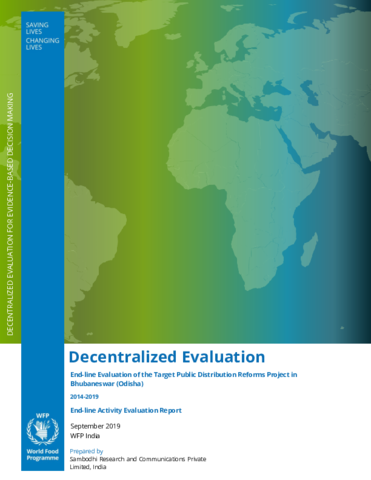
The National Food Security Act (NFSA) passed in 2013 marked a paradigm shift in the existing TPDS structure, moving from the delivery of subsidized food grains to a rights-based approach.
For Odisha, the TPDS reforms project were supported by the World Food Programme (WFP), India by formulating and implementing a plan for identification of right beneficiaries for delivery of food grains and for its distribution in a transparent and accountable manner at the Fair Price Shops (FPS), using technology and automation as the means to improve the overall efficiency and performance of the TPDS.
WFP India commissioned Sambodhi Research and Communications Private Limited (Sambodhi), India, to conduct an end-line activity evaluation of the TPDS reforms package in Bhubaneswar block and municipal corporation (MC), Odisha. The end-line activity evaluation covers the period of 2014 to 2019 and compares the results with the baseline evaluation conducted earlier in 2014.
The overall purpose of the end-line evaluation is to strengthen accountability by assessing performance and results of the TPDS reforms project and draw actionable learnings to inform operational and strategic decision making. The key measures for the end-line evaluation included assessing beneficiary targeting errors; service satisfaction and convenience among beneficiaries and FPS owners; and perception on the effectiveness of the existing grievance redressal mechanism.
The end-line activity evaluation employed a mixed-method pre-post longitudinal design along with Development Assistance Criteria (DAC) areas of inquiry. The evaluation used the longitudinal design re-visited 110 Primary Sampling Units (PSUs) surveyed during the baseline across Bhubaneswar block and Municipal Cooperation (MC) to collect qualitative and quantitative data on pre-identified indicators. The design for end-line evaluation also incorporated methods to measure effect of the programme on gender, in line with the Gender Equality and Empowerment of Women (GEEW) principles.
Quantitative structured interviews were conducted with 3300 randomly selected households (including both beneficiaries and non-beneficiaries) and 80 FPS owners to assess indicators The quantitative interviews, qualitative In-Depth Interviews (IDIs), qualitative Focus Group Discussions (FGDs). The quantitative indicators were assessed using probability weights.
